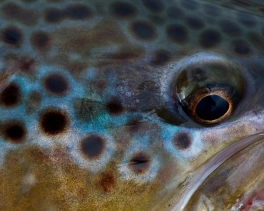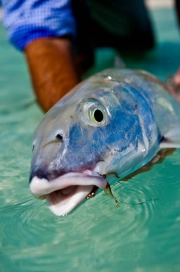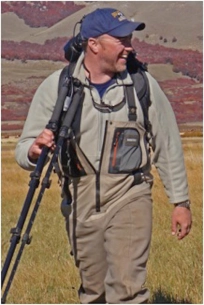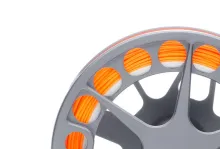This is the first article in a new series on Fishy Photographers built over the same template as our long-running Fishy Artists se
This is the first article in a new series on Fishy Photographers built over the same template as our long-running Fishy Artists series.
This premier article is about Jim Klug, known by any for his participation in the DVDs Drift and Rise and the recent Connect as well as his activities in the Yellow Dog Adventures fly fishing booking company. We have summoned Jim in his capacity as a photographer specializing in fly fishing, and presented him a row of questions.
How did you start photographing - and what made you choose fishing related photos in particular?
For me, it all started with fly fishing and travel. After years spent traveling to some pretty neat places - most of them fairly distant and off the grid - I recognized that there was an opportunity to create a business and a career that revolved around destination angling. That lead to the creation of Yellow Dog Flyfishing Adventures in 1999. Prior to starting Yellow Dog, I had been a casual/hobbyist photographer. But as the business began to grow, I realized the importance of having great images to help promote and sell the offerings that we had and the destinations that we represented. The funny thing is that I initially became serious about my photography for business reasons, trying my best to shoot without taking too much away from my fishing opportunities. These days, however, I am much more likely to be found in great fishing situations with a camera in my hand instead of a fly rod. Although I never thought I would ever hear myself say it, it has now gotten to the point where I get just as much satisfaction out of shooting great images and great fishing situations as I do fishing them myself.
These days I am much more likely to be found in great fishing situations with a camera in my hand instead of a fly rod.
Do you have a particular subject, region or a style of pictures that you mainly shoot or are you more all-round?
Well, for sure most of photography revolves around fly fishing situations and landscapes. And while the general themes usually involve fishing, the actual subjects definitely vary. I am extremely lucky in that my job with Yellow Dog sends me all over the world, which obviously creates amazing opportunities for shooting. If I had to characterize or label my style, I would probably call it "adventure-angling-destination-landscape-travel-photography."
Where are your photos used? Books, magazines, brochures, ads, web sites, prints, gallery exhibits or other places?
Pretty much all of the above! My images have started to run on a fairly regular basis in a lot of the U.S. fishing magazines. I'm starting to work with a number of magazines in Europe, Australia and Asia as well. I obviously use of ton of images for Yellow Dog's catalog and web materials, and have sold a handful of images to different companies and marketing campaigns. I do sell some prints and canvases on-line, and to a few small galleries and fly shops. I was recently contacted by a Montana brewery that wanted to do a summer-long showing of my images. I'm hoping that it will make for a summer of free beer!
Is photography your main source of income - if at all a source of income - and do you do other jobs as a supplement?
My main source of income is my job as the Director of Operations for Yellow Dog Flyfishing Adventures. A secondary "side project" that has actually started to turn into something significant is another company I am involved in called Confluence Films. We've created and released three fly fishing films over the past five years (DRIFT, RISE and CONNECT) that have all done quite well. Photography definitely supplements and compliments these two occupations, but there is no doubt that it is these two "main" jobs that allow me to travel the world and shoot amazing people, places, species and landscapes. All of this had made me a firm believer in the fact that in order to make a legitimate living in the fly fishing industry, it is a pretty good idea to have several "irons in the fire" with regards to income and sub-occupations.
Can people buy your pictures and if so, then in which form and where?
Yes please!
Most of my images are available at www.klugphotos.com. For custom canvases, larger prints and specialty images, I recommend that people contact me directly for options and orders.
Where do you currently live and work?
Bozeman, Montana (the center of the fly fishing universe) is where I live with my wife, children and dog. Surprisingly, I don't shoot a lot in Montana, as most of my photography - I guess you could say "where I work" - is out of the country.
I guess you could say "where I work" - is out of the country.
What's in your bag? Preferred cameras, bodies, lenses and other gear?
I've always been a Nikon guy. Right now I primarily shoot a Nikon D3S body, although I did just order the new D4, which I'm pretty excited about. For glass, for I usually travel with a five-lens "kit". A 24-70, 2.8 is my all-around, "go-to" lens. My second go-to lens is a 70-200 2.8, V2. I also carry a fixed 105 macro, a 16 fisheye, and a fixed 50 for low light and portrait-type shots. I have found that with these five lenses, I can pretty much cover every conceivable situation pretty much anywhere in the world. Something that I NEVER leave home without includes a heavy-duty Pelican case (which I always hope is as waterproof and durable as they claim it is). Another key piece of equipment that I bring everywhere is a carbon fiber tripod with a solid ball-head and a standard cable release. I use this set-up whenever possible - day and night. The tripod is light enough to travel with, but sturdy enough to hold the weight of a heavy body / larger lens combo. It is also beefy enough to hold up in tough conditions (i.e. saltwater). Other key pieces of equipment that I always travel with include circular polarized filters, a couple of different ND filters, double sided reflector panels that fold up into small pouches, a pile of spare batteries, cleaning clothes and wet lens wipes to deal with salt spray, a half-dozen extra memory cards, and various plastic shower caps and rain covers for shooting in wet conditions.
Jim's bio
Jim Klug is the founder and Director of Operations for Bozeman, Montana-based Yellow Dog Flyfishing Adventures. Jim began working in the fly fishing industry at the age of 14. Over the years, he has worked as a guide, sales rep, travel coordinator, and as past National Sales Manager for Scientific Anglers. He has guided extensively in Montana, Colorado, New Mexico and Oregon, and has fished throughout the world in over 25 different countries. In 2000, Jim founded Yellow Dog, a fly fishing booking company that has grown to become one of the largest entities in the fishing travel business. As Yellow Dog's Director of Operations, Jim spends a lot of time scouting and researching destinations in the Caribbean, Central and South America. Aside from his ongoing work with Yellow Dog, Jim is also the co-founder and executive producer for Confluence Films, a film production company that released the fly fishing movies DRIFT (2008), RISE (2009) and CONNECT (2011).
Jim's writings and photos and appeared in dozens of magazines and publications, and his photo work can be viewed at www.klugphotos.com. Jim lives in Bozeman, Montana with his wife Hilary and children Carson, Finn and Gus. He currently serves on the board of Belize's Turneffe Atoll Trust, the National Recreational Boating and Fishing Foundation, and is the current Chairman of the American Fly Fishing Trade Association (AFFTA).
- Log in to post comments














































